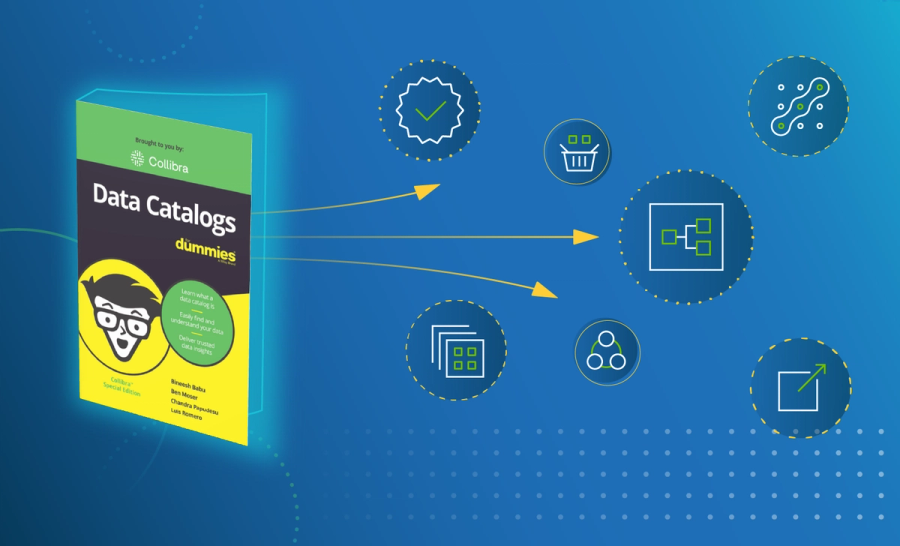How to build a data catalog: Step-by-step

Organizations recognize the need to continually innovate and adapt to meet customer needs while remaining competitive in the market. Many of these organizations possess a wealth of data but may lack a clear strategy to access and leverage its full value. The ability to gain visibility and insights from your own data should not be a massive, months-long undertaking. Collibra can assist your organization in discovering valuable insights from its data, no matter where you are in your data intelligence journey. The foundation for this end-to-end visibility is your data catalog.
Step 1: Create a strategy
The first step is to create a comprehensive strategy for implementing a data catalog, involving clear goals, objectives and a time frame.
- Decide on a realistic timeline to implement all the changes:You need to take into consideration the complexity of your data, the size of the organization and how many people need to be involved in the implementation of the catalog
- Figure out the issues you'd like to solve: To successfully implement a data catalog, begin by identifying key opportunities for improvement within your organization. A common first step is to address data silos by fostering collaboration among teams and connecting disparate data sources. Next, focus on establishing clear data ownership and applying consistent labels and definitions to all data assets. By tackling these foundational elements, you can build a robust data catalog that promotes data accessibility and understanding across your entire business."
- Select a data catalog tools:, Compare options and choose a platform that meets the unique needs of your company’s data. analyze metadata and implement to catalog your products.
Once you've documented and outlined your strategy, it's time to start looking at the metadata before implementing data catalog software tools to get the job done.
Step 2: Assess metadata
Metadata is the background information about your data that provides the source, context of datasets and usage of data. During the assessment process, you need to determine whether the current data information is valuable and how the data is being used. A spreadsheet of metadata could include customer information like demographic details of customers, owners of the spreadsheet, number of text and integer fields, source of data, dates of input and how often the spreadsheet is updated.
You need to create a metadata model and synchronize it across the organization and map out the exact data that's needed to provide valuable insights. This data will then be ingested into your data catalog.
Step 3: Implement data catalog software
There are a multitude of data catalog tools to help you find and understand data. These tools are often integrated with data governance software to help organizations stay current with regulatory compliance requirements. Advanced software programs automatically collect, organize, and clean data from various sources, including data warehouses, lakes, SQL databases, and the cloud. A unified governance approach, which Collibra champions, frees data from the constraints of silos by untethering governance from specific systems and sources. This provides true unified governance that gives you visibility, context, and control throughout the full data cycle. It also brings technical and business users into the fold to access and steward data.
Step 4: Keep the data catalog updated
Invest time in training teams on how to keep the data catalog updated. Create a company-wide data catalog tutorial to train team members. If it's not updated, it could lead to noncompliance and a loss of trustworthiness. Use APIs or plug-ins to make sure data is updated and capable of sending reminders. Organizations should have data owners who take responsibility for ensuring the validity of certain groups of data.
Optimize performance as needed
To optimize performance, you need to ensure regular indexing, conduct metadata refreshes, scale performance, secure and streamline access, update software and monitor system performance. You also need to archive and back up data and remove unqualified data. You can also look at using AI to assist with classifying and auto-tagging data, which can increase efficiency.
Best practices when building your data catalog
The data estate of organizations can vary from just a few data sources to a complex hybrid, multi-cloud ecosystem with increasingly large volumes of business data. As an organization matures so too will the amount and fragmentation of data. Without a unified view of data across the organization users are often unsure of what data exists within the organization since data is stored across numerous sources. They spend too much time and effort searching and trying to understand the data for their needs. Once they find potential data there is a lack of trust in the data stemming from the uncertainty in the quality, accuracy and completeness of the data.
This is where a data catalog platform can make trusted data discoverable and easy to access for your teams. Your teams can spend less time searching for data and more time extracting value from data, so you can drive better business decisions and better business outcomes. And with Collibra, you can start small and grow as your organization grows.
Connect, understand and trust
It all begins with connecting to your data, whether on-premises or in the cloud. A broad set of out-of-the-box integrations enable you to connect to your data sources including ETL tools, BI tools, and ERP and CRM systems.
With your most important business data connected and cataloged, now you can empower your teams with a personalized, self-service data marketplace experience to find the trusted data they need when they need it. But it doesn’t end there. You can start putting trust back into your data with rich context by connecting business, technical and privacy metadata with quality and lineage to drive better decisions. Get a complete understanding of how data flows throughout your organization and be confident that it is relevant and trustworthy. With effective data quality tools, you can proactively surface quality issues in real time and know that you are driving intelligent and informed decisions with the most reliable and accurate data.
At the end of the day, it’s all about enabling your organization with an easier way to find and understand data. The experience should be intuitive to anyone, so they can focus on building and sharing their best work. Teams can be brought together to discover, trust, access and share insights with the power of the data catalog.
See value in days not months
Get your data catalog up and running in record time. Collibra’s proven, pre-configured services get your integrations, data catalog, and lineage ready to go in days instead of months. The implementation is designed to deliver the most important, high-impact features first so that your team can start extracting immediate value. Avoid risks with established best practices that ensure things get done right the first time and avoid delays.
Don’t compromise your data strategy
A data catalog provides a solid foundation to your data intelligence strategy and will put you on the path to becoming a data-driven organization. The key is to maximize the value of your data with a solution that is right-sized to your business needs and can evolve with your organization.
In this post:
- Step 1: Create a strategy
- Step 2: Assess metadata
- Step 3: Implement data catalog software
- Step 4: Keep the data catalog updated
- Optimize performance as needed
- Best practices when building your data catalog
- Connect, understand and trust
- See value in days not months
- Don’t compromise your data strategy
Related articles

Data GovernanceApril 17, 2025
Strengthening data reliability at WGU through smarter governance

PartnerJanuary 26, 2024
Collibra is proud to be part of the Snowflake Horizon Partner Ecosystem

Data CatalogMay 22, 2023
Facing your data challenge with a data catalog

Data CatalogJuly 25, 2023
7 steps to data intelligence
Keep up with the latest from Collibra
I would like to get updates about the latest Collibra content, events and more.
Thanks for signing up
You'll begin receiving educational materials and invitations to network with our community soon.
